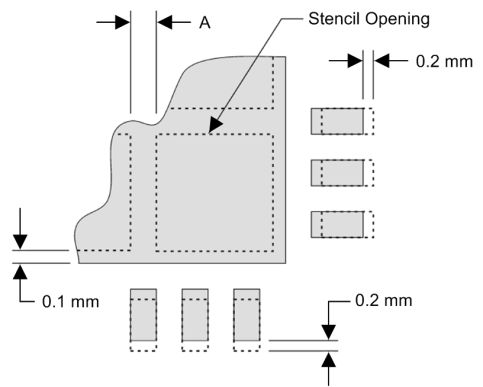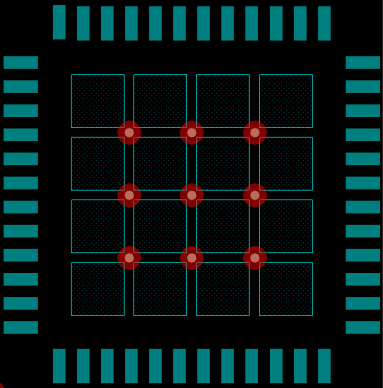SNLS420D July 2012 – July 2015 DS90UB913Q-Q1 , DS90UB914Q-Q1
PRODUCTION DATA.
- 1 Features
- 2 Applications
- 3 Description
- 4 Revision History
- 5 Description continued
- 6 Device Comparison Table
- 7 Pin Configuration and Functions
-
8 Specifications
- 8.1 Absolute Maximum Ratings
- 8.2 ESD Ratings
- 8.3 Recommended Operating Conditions
- 8.4 Thermal Information
- 8.5 Electrical Characteristics
- 8.6 Timing Requirements: Recommended for Serializer PCLK
- 8.7 AC Timing Specifications (SCL, SDA) - I2C Compliant
- 8.8 Bidirectional Control Bus DC Timing Specifications (SCL, SDA) - I2C Compliant
- 8.9 Switching Characteristics: Serializer
- 8.10 Switching Characteristics: Deserializer
- 8.11 Typical Characteristics
- 9 Parameter Measurement Information
-
10Detailed Description
- 10.1 Overview
- 10.2 Functional Block Diagram
- 10.3
Feature Description
- 10.3.1 Serial Frame Format
- 10.3.2 Line Rate Calculations for the DS90UB91xQ
- 10.3.3 Deserializer Multiplexer Input
- 10.3.4 Error Detection
- 10.3.5 Description of Bidirectional Control Bus and I2C Modes
- 10.3.6 Slave Clock Stretching
- 10.3.7 I2C Pass-Through
- 10.3.8 ID[x] Address Decoder on the Serializer
- 10.3.9 ID[x] Address Decoder on the Deserializer
- 10.3.10 Programmable Controller
- 10.3.11 Synchronizing Multiple Cameras
- 10.3.12 General-Purpose I/O (GPIO) Descriptions
- 10.3.13 LVCMOS VDDIO Option
- 10.3.14 Deserializer - Adaptive Input Equalization (AEQ)
- 10.3.15 EMI Reduction
- 10.4
Device Functional Modes
- 10.4.1 DS90UB91xQ-Q1 Operation With External Oscillator as Reference Clock
- 10.4.2 DS90UB91xQ-Q1 Operation With Pixel Clock from Imager as Reference Clock
- 10.4.3 MODE Pin on Serializer
- 10.4.4 MODE Pin on Deserializer
- 10.4.5 Clock-Data Recovery Status Flag (LOCK), Output Enable (OEN) and Output State Select (OSS_SEL)
- 10.4.6 Multiple Device Addressing
- 10.4.7 Powerdown
- 10.4.8 Pixel Clock Edge Select (TRFB / RRFB)
- 10.4.9 Power-Up Requirements and PDB Pin
- 10.4.10 Built-In Self Test
- 10.4.11 BIST Configuration and Status
- 10.5 Register Maps
- 11Application and Implementation
- 12Power Supply Recommendations
- 13Layout
- 14Device and Documentation Support
- 15Mechanical, Packaging, and Orderable Information
パッケージ・オプション
デバイスごとのパッケージ図は、PDF版データシートをご参照ください。
メカニカル・データ(パッケージ|ピン)
- RHS|48
サーマルパッド・メカニカル・データ
発注情報
13 Layout
13.1 Layout Guidelines
Printed-circuit-board layout and stack-up for the serializer and deserializer devices should be designed to provide low-noise power feed to the device. Good layout practice will also separate high frequency or high-level inputs and outputs to minimize unwanted stray noise pickup, feedback and interference. Power system performance may be greatly improved by using thin dielectrics (2 to 4 mils) for power/ground sandwiches. This arrangement provides plane capacitance for the PCB power system with low-inductance parasitics, which has proven especially effective at high frequencies, and makes the value and placement of external bypass capacitors less critical. External bypass capacitors should include both RF ceramic and tantalum electrolytic types. RF capacitors may use values in the range of 0.01 µF to 0.1 µF. Tantalum capacitors may be in the 2.2-µF to 10-µF range. Voltage rating of the tantalum capacitors should be at least 5× the power supply voltage being used.
Surface mount capacitors are recommended due to their smaller parasitics. When using multiple capacitors per supply pin, locate the smaller value closer to the pin. A large bulk capacitor is recommend at the point of power entry. This is typically in the 50-µF to 100-µF range and will smooth low frequency switching noise. It is recommended to connect power and ground pins directly to the power and ground planes with bypass capacitors connected to the plane with a via on both ends of the capacitor. Connecting power or ground pins to an external bypass capacitor will increase the inductance of the path.
A small body size X7R chip capacitor, such as 0603, is recommended for external bypass. Its small body size reduces the parasitic inductance of the capacitor. The user must pay attention to the resonance frequency of these external bypass capacitors, usually in the range of 20 to 30 MHz. To provide effective bypassing, multiple capacitors are often used to achieve low impedance between the supply rails over the frequency of interest. At high frequency, it is also a common practice to use two vias from power and ground pins to the planes, reducing the impedance at high frequency.
Some devices provide separate power for different portions of the circuit. This is done to isolate switching noise effects between different sections of the circuit. Separate planes on the PCB are typically not required. Pin description tables typically provide guidance on which circuit blocks are connected to which power pin pairs. In some cases, an external filter many be used to provide clean power to sensitive circuits such as PLLs.
Use at least a four-layer board with a power and ground plane. Locate LVCMOS signals away from the differential lines to prevent coupling from the LVCMOS lines to the differential lines. Closely-coupled differential lines of 100 Ω are typically recommended for differential interconnect. The closely coupled lines help to ensure that coupled noise will appear as common-mode and thus is rejected by the receivers. The tightly coupled lines will also radiate less.
Information on the WQFN style package is provided in Texas Instruments' Application Note: AN-1187 (SNOA401).
See AN-1108 (SNLA008) and AN-905 (SNLA035) for full details.
- Use 100-Ω coupled differential pairs
- Use the S, 2S, and 3S rule in spacings
- S = space between the pair
- 2S = space between pairs
- 3S = space to LVCMOS signal
- Minimize the number of Vias
- Use differential connectors when operating above 500Mbps line speed
- Maintain balance of the traces
- Minimize skew within the pair
Additional general guidance can be found in the LVDS Owner’s Manual - available in PDF format from the Texas Instrument web site at: www.ti.com/lvds
13.2 Layout Example
Stencil parameters such as aperture area ratio and the fabrication process have a significant impact on paste deposition. Inspection of the stencil prior to placement of the WQFN package is highly recommended to improve board assembly yields. If the via and aperture openings are not carefully monitored, the solder may flow unevenly through the DAP. Stencil parameters for aperture opening and via locations are shown in Figure 50.
 Figure 50. No Pullback WQFN, Single Row Reference Diagram
Figure 50. No Pullback WQFN, Single Row Reference Diagram
Figure 50 and Figure 51 PCB layout examples are derived from the layout design of the DS90UB913Q-Q1 Serializer and DS90UB914Q-Q1 Deserializer Evaluation Kit (SNLU110). These graphics and additional layout description are used to demonstrate both proper routing and proper solder techniques when designing in the serializer and deserializer.
Table 11. No Pullback WQFN Stencil Aperture Summary for DS90UB913Q-Q1 and DS90UB914Q-Q1
| DEVICE | PIN COUNT | MKT DWG | PCB I/O PAD SIZE (mm) |
PCB PITCH (mm) | PCB DAP SIZE (mm) |
STENCIL I/O APERTURE (mm) | STENCIL DAP APERTURE (mm) | NUMBER OF DAP APERTURE OPENINGS | GAP BETWEEN DAP APERTURE (Dim A mm) |
|---|---|---|---|---|---|---|---|---|---|
| DS90UB913Q-Q1 | 32 | RTV | 0.25 x 0.6 | 0.5 | 3.1 x 3.1 | 0.25 x 0.7 | 1.4 x 1.4 | 4 | 0.2 |
| DS90UB914Q-Q1 | 48 | RHS | 0.25 x 0.6 | 0.5 | 5.1 x 5.1 | 0.25 x 0.7 | 1.1 x 1.1 | 16 | 0.2 |
 Figure 51. 48-Pin WQFN Stencil Example of Via and Opening Placement
Figure 51. 48-Pin WQFN Stencil Example of Via and Opening Placement